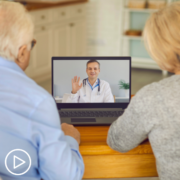How Are Rural CAR T-Cell Therapy Barriers Being Addressed?
How Are Rural CAR T-Cell Therapy Barriers Being Addressed? from Patient Empowerment Network on Vimeo.
How are barriers to CAR T-cell therapy care in rural areas being reduced? Expert Dr. Sikander Ailawadhi from Mayo Clinic discusses positive patient care developments from COVID and how patients can help optimize their care.
[ACT]IVATION TIP
“…over these past few years, post-COVID, we have learned how to deliver healthcare in a more patient-centric manner, and we are using those factors, those tools, those techniques, to be able to bring CAR T and its associated care to a lot of many more patients. I still would like patients to seek out care as and when possible.”
See More from [ACT]IVATED CAR T
Related Resources:

|

How Can Information Disparities on Emerging Therapies Be Addressed? |

|
Transcript:
Lisa Hatfield:
Dr. Ailawadhi, logistical challenges exist in delivering CAR T-cell therapy to patients, especially in rural or underserved areas. Can you speak to any innovative delivery models that could improve access?
Dr. Sikander Ailawadhi:
This is an extremely important, but also an exciting question to ask, Lisa, whether we have some interesting models or innovative healthcare delivery models that are trying to overcome some of these access barriers to CAR T-cell therapy. So, one thing that COVID has taught us is that medicine does not need to be delivered or healthcare does not need to be delivered in a cookie cutter fashion as we were doing it before. Suddenly, after COVID, I’m glad that we all as a community, as a society, pivoted and started delivering telemedicine care.
So, we are still doing a lot of telemedicine. I’ll give you the example of one case who’s near and dear to me, because she did come through a lot of adversity to get to this point. A relatively younger lady with multiple myeloma, who’s an international patient, and she came from Middle East, she had already received two transplants and had run through all the treatment options available locally.
She had some family members and some means that she could actually come here, so she came to the U.S., did a consult, we did a visit, we took over her treatment, she got CAR T, but then a month or so after that she was doing fine and she wanted to go back home. She was here with some family members living in a foreign country, not speaking the language, et cetera. Her children were very supportive and spoke English. So, she went back and I still continue to do video visits with her just to see how she’s doing, monitor her disease, she sends me records through the electronic medical system portal, I can see her labs, and I think it gives me peace of mind that I’m keeping an eye on it, it gives her peace of mind.
And I don’t think a lot of it would have been possible without the tools that we have at our disposal, now, for example, telemedicine. Now, certain institutions do have other opportunities, like they have mobile clinics, they will actually go to the patients where they are. We, for example, at Mayo Clinic in the Midwest, in Minnesota, we have a health system that is present throughout three different states in the Midwest, where we have smaller clinics where the patients could go to and receive all their care, except for the CAR T portion for which they can come to the main site.
We also have something set up, for example, at Mayo called remote patient monitoring. We have something called acute care at home, in which we are providing a lot of this CAR T-cell therapy as an outpatient. Patients can receive their cells but can be discharged very early. And then a lot of these remote monitoring services we are using to help patients stay where they are, feel safe, not being stuck in a hospital room, and are able to receive their care sometimes in their homes with their caregivers and family members by their side, and they feel more comfortable about it.
So a lot of these things that we are doing to provide access to care to patients, and I would also say, this is helping overcome some healthcare disparities also, because some of those patients who have challenges or barriers to the access, but by doing these innovative things of telemedicine, at home care, remote monitoring care, et cetera, we are suddenly overcoming some of those barriers. For example, the patient needing to go to the hospital, the patient needing to have a caregiver who has to miss time from work just because they have to be at the hospital, et cetera.
So my activation tip for this question is that over these past few years, post-COVID, we have learned how to deliver healthcare in a more patient-centric manner, and we are using those factors, those tools, those techniques, to be able to bring CAR T and its associated care to a lot of many more patients. I still would like patients to seek out care as and when possible.






